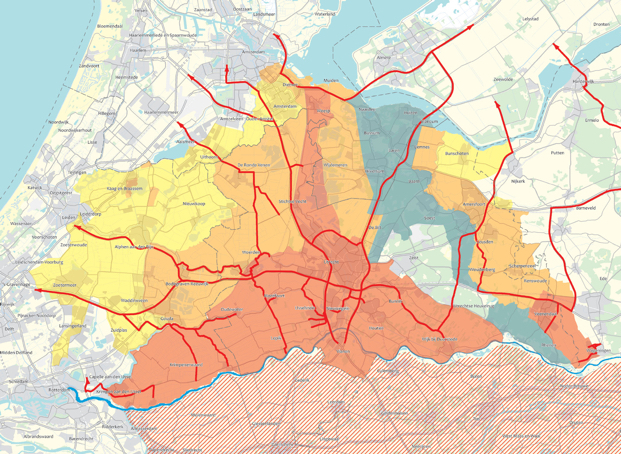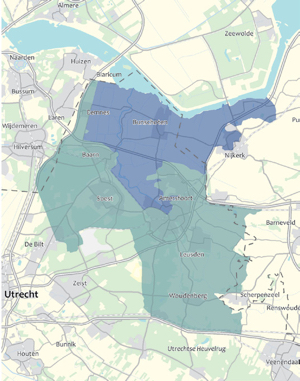public concern
— In-depth

01 / Rising waterlevels of the Lower Rhine and Lek
The reality of accelerating climate change

For many regions, the accelerating climate change results in more extreme precipitation patterns and rising water levels of various bodies of water. In the Utrecht region, this puts pressure on the retention and drainage capacity of rivers and catchment areas.
For the Utrecht region, the choice to take on an adaptive approach to climate change is a natural choice. By combining previous learning with the knowledge provided by the Regional Water Authority Hoogheemraadschap De Stichtse Rijnlanden and the Royal Netherlands Meteorological Institute - also situated in the Utrecht region - the region is well prepared for a worst-case scenario.
Developing an adaptive strategy
The first part of the region’s adaptive risk management strategy consists of preventing worst-case scenario. The strengthening and maintenance of the Lek Dike is an example of where the public sector takes the lead in decreasing the chance of flooding occurring in the future.
It is a good example of a project that needs to be instigated by the public sector because,

02 / Heavy storm on the Eem lake
if the Lek Dike collapses, that could potentially flood the entire western half of the Netherlands. Simultaneously, an emergency flood evacuation plan has been developed and communicated. Why prepare for the worst-case scenario if the dikes are being strengthened? Ultimately, 100% safety cannot be guaranteed. Predictions can prove inaccurate and human intervention can also impact the dike’s efficiency.
In Brief
Three ways of working with stakeholders will improve the Lek Dike strengthening and maintenance project:
01/
03
Stronger: adding nature or buildings to the dike can be a way of making the dike structurally stronger.
02/
03
Faster: involving residents in the project, will lead to a speedier process and better results.
03/
03
Budget: by partnering with cultural, historic and ecological preservation organizations, a higher budget can be made available for maintenance and strengthening activities.
03 / A storm lasting multiple days on the North Sea
Furthermore, the evacuation plan makes the urgency and reality of climate threats very visible. This creates a sense of ownership among citizens and other parties.
In my backyard, please!
Strategies that pro-actively adapt to climate change while they are not a response to an acute crisis, can be subject to resistance.
To minimize the ‘not in my backyard’ response that the reinforcement of the Lek Dike can evoke, the Utrecht region continually involves a broad range of stakeholders.
Rather than approaching stakeholder dialogue as a necessary evil, this engagement means that maintenance work can be carried out more effectively, faster and with a larger budget.
public concern
— In-depth
Next up / Inspiration →